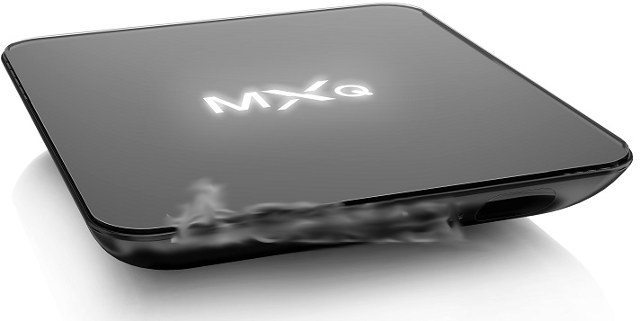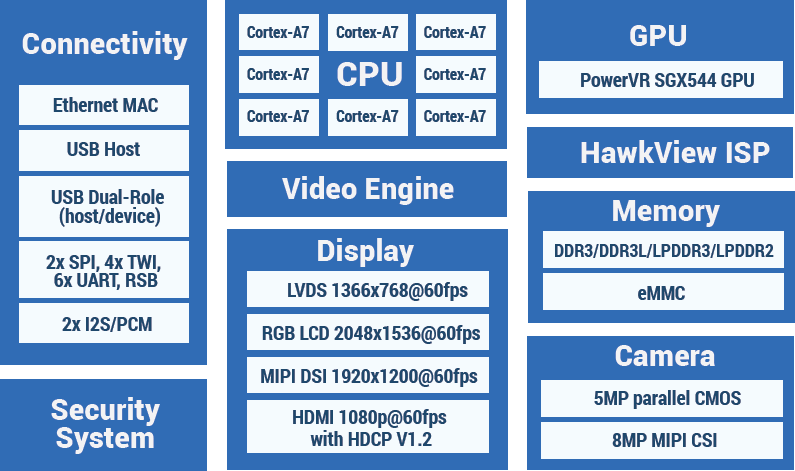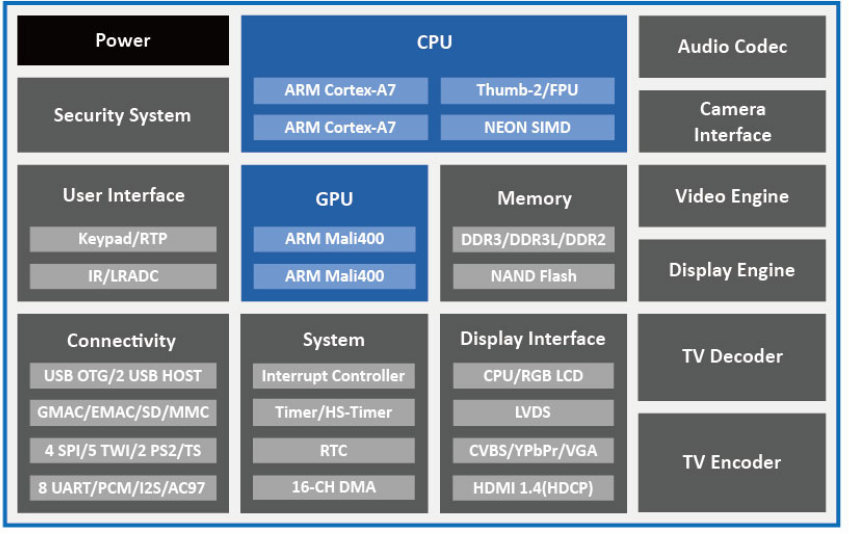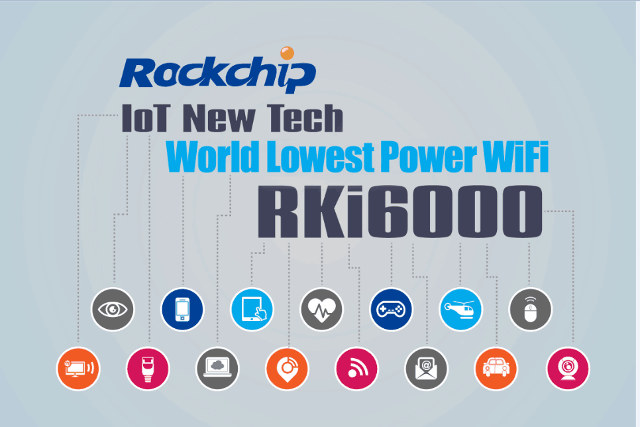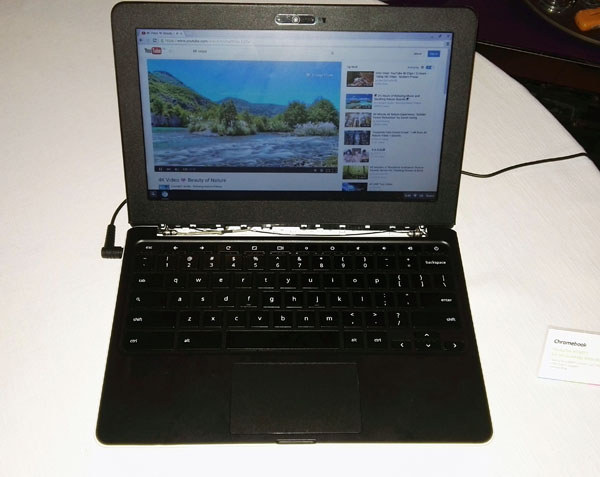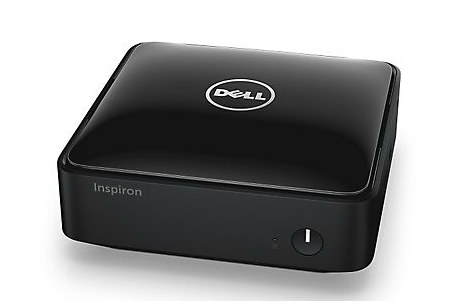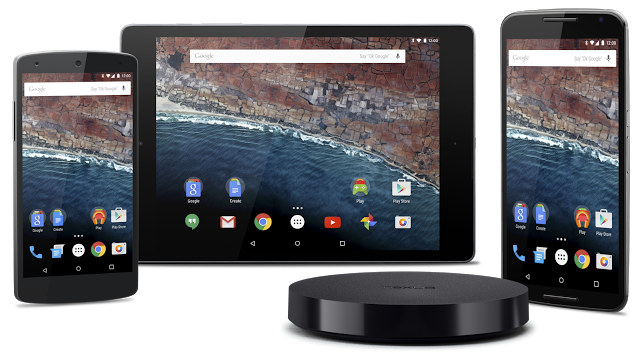We’ve learned that Amlogic was working on S905 and S912 64-bit ARM processors a little while ago, and one of the first product to market featuring Amlogic S905 processor could be Acemax G9C. ACEMAX G9C specifications: SoC – Amlogic S905 quad core ARM Cortex-A53 @ up to 2.0GHz with penta-vore Mali-450MP GPU up to 750MHz+ System Memory – 2GB DDR3 Storage – 8GB NAND flash (Bigger Memory Optional) + micro SD card slot Video Output – HDMI 2.0, AV Video Codecs – 1080p/4k2k H.264, H.265, HD AVC/VC-1, HD MPEG1/2/4, RM/RMVB, Xvid/DivX 3/4/5/6, RealVideo 8/9/10 Audio – HDMI, AV, coaxial S/PDIF Connectivity – 10/100M Ethernet, Wi-Fi @ 2.4GHz USB – 2x USB 2.0 host ports Power Supply – DC 5V/2A Dimensions – 125 x 120 x 20 mm The box is said to run Android 5.0. That’s about all we know about the box right now, as availability and pricing are […]
Allwinner R58 Octa-core Processor Targets 2-in-1 Android Laptops
Allwinner R-series processor family, such as Allwinner R8, is supposed to target “IoT applications”, but IoT must have recently taken a whole new meaning as the latest Allwinner R58 octa-core processor targets 2-in-1 laptops running Android. Allwinner website however lists R58 as an high-end IoT platform for virtual reality and robotics. Allwinner R58 specifications: CPU – Octa-Core Cortex-A7 CPU up to 2.0 GHz GPU – PowerVR SGX544 GPU @ 600 MHz with support for OpenGL ES 2.0/1.1, OpenCL 1.1, DX 9_3 Memory 32-bit DDR3/DDR3L/LPDDR3/LPDDR2 SLC/MLC/TLC/EF NAND with 64-bit ECC eMMC V4.5 Video 1080p@60fps video playback multi-format video playback, including H.264, MPEG1/2, MPEG4 SP/ASP GMC, H.263 including Sorenson Spark, WMV9/VC-1, JPEG/MJPEG, etc H.264 1080p@60fps or 720p@120fps video capture Display LVDS up to 1366×768@60fps or RGB LCD up to 2048×1536@60fps 4-lane MIPI DSI up to 1920×1200@60fps HDMI up to 1080p@60fps, HDCP V1.2 supported Dual display supported with LCD up to 720p@60fps and […]
Allwinner T2 Dual Core Processor is Made for Automotive Infotainment and Navigation
Allwinner already has several processor families, the most famous being the A-series for tablets, followed bythe H-series for home entertainment, the V-series for video application, the R-series for IoT as found in R8 module used in C.H.I.P $9 computer, and now I’ve just found out the company launched T-series with Allwinner T2 and T8 for “Transportation”/automotive applications. I don’t have any details about T8 processor, but the company kindly shared a product brief with the specs for Allwinner T2: CPU – Dual core Cortex A7 CPU – Mali-400MP2 supporting OpenGL ES 1.1/2.0 Memory – DDR2, DDR3, and DDR3L controller, NAND flash controller with 64-bit ECC Video Inputs – 4x AV Inputs Video – H.264 2160p video decoding, multi-format decoding, h.264 encoding @1080p30 / 720p60. Display – Multi-channel HD display with integrated HDMI 1.4 transmitter, CPU/RGB/LVDS display interface, support for VGA/CVBS/YPbPr, and integrated TV decoder. Camera – Integrated parallel 8-bit interface YUV sensor, […]
Rockchip RKi6000 WiFi SoC Promises Bluetooth 4.0 Power Consumption Levels
Rockchip has announced a new WiFi SoC for IoT applications claiming 85% lower power consumption compared to competing WiFi solutions, which allows cell-coin battery powered WiFi systems thanks to a power consumption equivalent to what you’d get with a Bluetooth 4.0 LE system. Rockchip RKi6000 is said to consume 20 mA (@ 3.3V) during Rx operations. The SoC has been developed with an unnamed third party, and can achieve a lower power consumption thanks to three improvements: Improvement of RF transceiver architecture. The architecture can greatly reduce the active power consumption of IoT smart devices during continuous data transfer. Ultra low power can be achieved both in work and standby mode. Dozens of international patents have been filed for this technology. Adaptive dynamic power control technology. Power efficiency is optimized in different working modes and the total power consumption is reduced greatly in different application scenarios by adjusting the chip’s power […]
Chromebooks with Mediatek MT8173 Cortex A72 Showcased at Computex 2015
Chromebooks were originally all based on Intel processor, but eventually ARM based Chromebooks got launched starting with Samsung Exynos, more recently Rockchip RK3288, and soon we’ll have Mediatek Chromebooks based on their latest Cortex A72 + A53 processor. The platform is still in development, but some prototypes are being shown up at Computex 2015 in Taipei. The full specs are not available but we do know the laptop features MT8173 SoC with 2x Cortex A72 cores, 2x Cortex A53 cores, and a PowerVR GX6250 GPU. NotebookItalia is at Computex and in their short video below with can hear the spokesman claiming support for 4K video playback, 2K display, and the presence of Type C USB port that can be used to connect device, but also charging the laptop. Mediatek Chromebooks should offer about twice the single thread performance as Rockchip RK3288 devices, thanks to the use Cortex A72 cores instead […]
Dell Inspiron Micro Desktop with Intel Celeron J1800 or Pentium J2900 Starts at $180
We’ve already seen Chinese mini PCs based on Intel Bay Trail-D processors for less than $200, even with a 500 GB HDD as found in VX2 mini PC, but if you’d like to buy from a more established brand, Dell has launched two models of Inspiron 3050 Micro Desktop with Intel Celeron J1800 (dual core) and Pentium J2900 (quad core) selling respectively for $179.99 and $229.99 direct from Dell US, and they also have built-in Gigabit Ethernet and 802.11ac that you may not always find in the cheaper Chinese models. Beside the different processors, but models share the same specifications: SoC Intel Celeron J800 dual core processor @ up to 2.58GHz with Intel HD graphics Intel Pentium J2900 quad core processor @ up to 2.67 with Intel HD graphics System Memory – 2GB DDR3L @ 1600MHz (SO-DIMM slot, up to 8GB supported) Storage – 32GB SSD, SATA 3Gbps (up to […]
Linaro 15.05 Release with Linux 4.1 and Android 5.1
Linaro 15.04 has been released with Linux 4.1-rc4, Linux 3.10.79 and 3.14.42 (LSK), and Android 5.1_r3. The Ubuntu image is now based on Vivid instead of Utopic. Android and Debian builds/images have been released for Hikey’s 96boards, Ubuntu Vivid and Android builds have been setup for Qualcomm’s Dragonboard 410c. A new platform, Socionext M8M, has also show in Linaro changelog. I could not find details about M8M, but Socionext is a “new company that designs, develops and delivers System-on-Chip products” and focuses on “imaging, networking and other dynamic technologies”. Their latest press release mentions a 4K media processor with build-in HDMI 2.0 Tx and Rx, so maybe M8M is based on that processor, but I can’t know for sure as they have several chips. Highlights of this release: Linux Linaro 4.1-rc4-2015.05 GATOR updated to version 5.21.1 updated integration-linaro-vexpress64 topic by ARM LT: PCI support added – for Juno r1. Linaro […]
Android M Preview Images & SDK and Key Changes
Google formally announced Android M (Marshmallow?) at Google I/O, and released preview images for Nexus 5, Nexus 6, Nexus 9, and the Nexus player. If you don’t own any of these devices, you can also run Android M in the emulator using the preview SDK. So what’s new in Android M? Google reports over 100 changes, but here are some of the highlights of improvements and new features: User Control of Permissions – With Android M, apps can trigger requests for permissions at runtime, and let users choose whether to allow it. For example, if your flashlight app suddenly request access to your contact list, a window may pop up and you are free to decline it. Users will also have easy access to manage all their app permissions in settings. Doze improves Battery Life – Android M will use motion detection to learn if a device has been used […]


